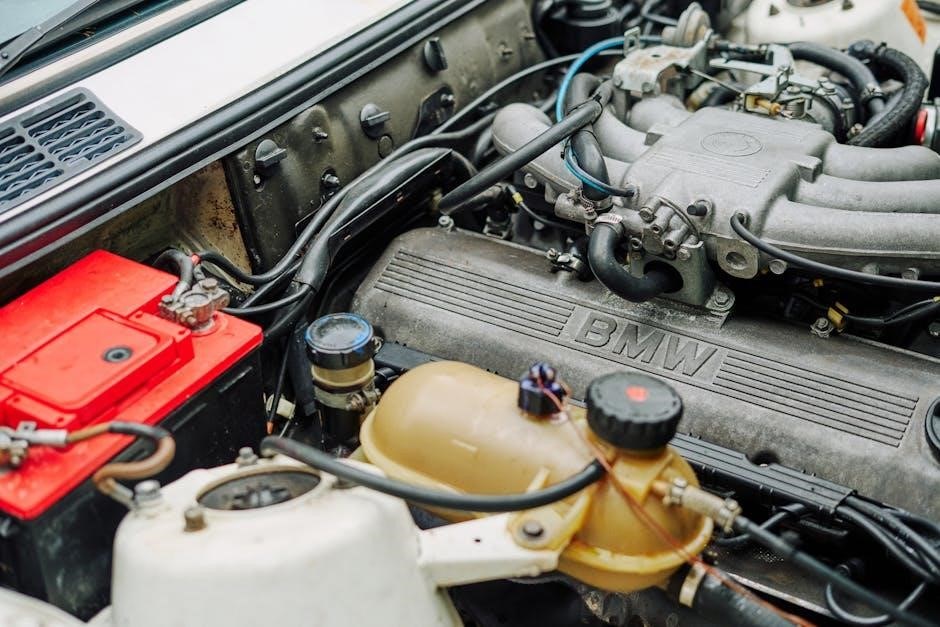for who a car manual is written
Car manuals are essential guides written primarily for vehicle owners but also catering to professional mechanics, enthusiasts, and collectors. They provide detailed information on maintenance, repairs, and optimal usage, ensuring safe and efficient operation of vehicles for diverse audiences.
1.1 Purpose and Importance of Car Manuals
Car manuals are essential resources designed to guide vehicle owners, mechanics, and enthusiasts in understanding and using their vehicles effectively. Their primary purpose is to provide detailed information on safe operation, maintenance, and repair procedures. These manuals ensure that users can optimize their vehicle’s performance, longevity, and safety. They also serve as a reference for troubleshooting common issues and customizing vehicles according to individual preferences. By adhering to the guidelines in car manuals, users can comply with regulatory standards and minimize risks associated with improper vehicle handling. Ultimately, car manuals are indispensable tools for promoting responsible car ownership, efficient repairs, and enhanced driving experiences for diverse audiences.
1.2 Overview of Car Manuals
Car manuals are comprehensive guides that provide detailed information about a vehicle’s operation, maintenance, and repair. They are typically written by experts, including technical writers, engineers, and test drivers, to ensure accuracy and clarity. These manuals cover a wide range of topics, from basic vehicle systems and technical specifications to troubleshooting and advanced customization. They are designed to cater to various audiences, including car owners, professional mechanics, DIY enthusiasts, and automotive students. Modern car manuals often include interactive features like diagrams, animations, and step-by-step instructions to enhance user understanding. By offering both practical and technical insights, car manuals serve as indispensable resources for anyone involved with vehicles, promoting safety, efficiency, and compliance with industry standards.

Target Audience of Car Manuals
Car manuals are written for car owners, drivers, professional mechanics, DIY enthusiasts, automotive students, and industry professionals, providing essential information for safe operation, maintenance, and customization.

2.1 Car Owners and Drivers
Car manuals are vital for car owners and drivers, providing essential information for safe and efficient vehicle operation. They include guidelines for routine maintenance, troubleshooting common issues, and understanding safety features. Manuals also offer insights into customization and upgrades, helping owners personalize their vehicles. By adhering to the manual’s instructions, drivers can ensure optimal performance, longevity, and compliance with safety standards. This resource empowers owners to make informed decisions, perform basic maintenance, and address minor problems independently, reducing reliance on professional services. Ultimately, car manuals serve as a comprehensive guide to maximizing vehicle potential and ensuring a safe driving experience for all users.
2.2 Professional Mechanics and Technicians
Car manuals are indispensable tools for professional mechanics and technicians, offering detailed repair procedures, technical specifications, and diagnostic guidance. These resources provide step-by-step instructions for complex repairs, ensuring accuracy and efficiency. Manuals include diagrams, technical data, and advanced customization options, enabling professionals to handle sophisticated modifications and troubleshooting. They also serve as a reference for staying updated on new technologies and manufacturer guidelines. By following the manual’s instructions, mechanics can perform repairs confidently, adhering to industry standards and safety protocols. This ensures optimal vehicle performance, reliability, and compliance with regulatory requirements, making car manuals a cornerstone of professional automotive work.
2.3 DIY Enthusiasts and Car Enthusiasts
Car manuals are invaluable for DIY enthusiasts and car enthusiasts, providing detailed guidance for basic repairs, troubleshooting, and customization. These individuals often seek to understand and enhance their vehicles, and manuals offer step-by-step instructions for maintenance, upgrades, and performance improvements. Enthusiasts appreciate the cost-effective solutions and practical advice found in manuals, which empower them to take control of their car’s care. Manuals also cater to their curiosity, explaining complex systems and offering insights into advanced modifications. By enabling hands-on involvement, car manuals foster a deeper connection between enthusiasts and their vehicles, making ownership more engaging and rewarding while ensuring safety and optimal performance.
2.4 Automotive Students and Learners
Car manuals are vital educational resources for automotive students and learners, offering comprehensive insights into vehicle systems, components, and repair procedures. They provide detailed explanations of how engines, transmissions, brakes, and electrical systems function, serving as practical textbooks for hands-on learning. Manuals also include troubleshooting guides and maintenance schedules, helping students develop diagnostic and problem-solving skills. Additionally, they keep learners updated on the latest automotive technologies, ensuring they are well-prepared for industry advancements. By combining theoretical knowledge with real-world applications, car manuals are indispensable tools for training future professionals, fostering a deep understanding of vehicle mechanics and equipping students with the skills needed for successful careers in the automotive field.

2.5 Automotive Industry Professionals
Car manuals are indispensable resources for automotive industry professionals, providing detailed technical specifications, diagrams, and manufacturer guidelines. They ensure compliance with industry standards and regulatory requirements, offering updates on new technologies and best practices. Manuals serve as reference materials for professionals, enabling them to stay informed about vehicle systems, diagnostic procedures, and advanced modifications. They also include technical bulletins and service updates, ensuring professionals are equipped with the latest information to maintain and repair vehicles effectively. By adhering to the guidelines outlined in car manuals, industry professionals can deliver high-quality services, meet safety standards, and uphold manufacturer recommendations, ultimately supporting the integrity and performance of vehicles in the automotive sector.

Car Owners and Drivers
Car manuals provide essential guidance for safe vehicle operation, maintenance, and troubleshooting, helping owners understand features, customize settings, and ensure optimal performance and longevity of their cars.

3.1 Safe Operation of the Vehicle
Car manuals play a crucial role in ensuring the safe operation of vehicles by providing detailed information on safety features, proper driving practices, and adherence to traffic laws. They outline the correct usage of seatbelts, airbags, and other safety systems, ensuring drivers understand how to operate their vehicles safely. Manuals also include guidelines for loading vehicles correctly and securing cargo to prevent accidents. By following the manual’s instructions, drivers can minimize risks on the road, ensuring the well-being of themselves and passengers. This section emphasizes the importance of understanding and adhering to safety protocols to prevent accidents and maintain compliance with legal requirements.
3.2 Maintenance and Servicing Guidelines
Car manuals provide comprehensive maintenance and servicing guidelines to ensure vehicles operate efficiently and last longer. They include detailed schedules for routine tasks like oil changes, tire rotations, and fluid checks, specifying recommended intervals to maintain optimal performance. Manuals also outline procedures for inspecting brakes, batteries, and belts, helping owners identify potential issues early. Additionally, they offer troubleshooting tips for common problems, guiding users on how to address minor issues before they escalate. By following these guidelines, car owners can prevent costly repairs, enhance safety, and ensure their vehicles remain in peak condition. Regular maintenance, as outlined in the manual, is crucial for preserving the vehicle’s health and reliability over time.
3.3 Troubleshooting Common Issues
Car manuals are invaluable for troubleshooting common issues, providing step-by-step guidance to help users identify and resolve problems. They include detailed instructions for diagnosing issues like warning lights, unusual noises, or performance problems. Manuals often feature diagrams and charts to simplify complex procedures, ensuring users can address issues safely and effectively. By following the manual, car owners and mechanics can pinpoint the root cause of a problem, whether it’s a faulty sensor, worn-out part, or software glitch. This helps in resolving issues efficiently, reducing repair costs and downtime. Troubleshooting sections empower users to take control of minor repairs, enhancing their confidence and saving money. Regular use of these guides ensures vehicles remain reliable and perform optimally over time.
3.4 Customization and Upgrades
Car manuals provide valuable guidance for customization and upgrades, helping users personalize their vehicles while maintaining safety and performance. They offer step-by-step instructions for modifying features like interior styling, infotainment systems, and performance enhancements. Manuals ensure that upgrades align with manufacturer specifications, preventing voidance of warranties or safety risks. DIY enthusiasts and car owners can explore aftermarket modifications, such as engine tuning or suspension upgrades, with confidence. The manual also highlights manufacturer-approved accessories and compatibility, ensuring seamless integration; By following these guidelines, users can enhance their vehicles aesthetic appeal, functionality, and performance without compromising reliability. This section empowers owners to tailor their cars to their preferences while adhering to safety and regulatory standards.
3.5 Safety Features and Compliance
Car manuals emphasize safety features and compliance, ensuring users understand their vehicles’ safety systems and regulatory requirements. They provide detailed instructions for using safety equipment, such as airbags, seat belts, and child restraints. Manuals highlight essential safety protocols, including proper vehicle maintenance and operation practices to minimize risks. Compliance with legal and manufacturer standards is stressed, covering aspects like emissions and roadworthiness. Clear warnings and guidelines help drivers avoid hazardous situations, while adherence to these standards ensures vehicles operate safely and responsibly. By prioritizing safety and compliance, car manuals empower owners to protect themselves, passengers, and others on the road, fostering a culture of responsible driving and vehicle ownership.

Professional Mechanics and Technicians
Car manuals are written for professional mechanics and technicians, providing detailed repair procedures, technical specifications, and diagnostic guidance to ensure accurate and efficient vehicle servicing and maintenance.
4.1 Detailed Repair Procedures
Car manuals provide professional mechanics and technicians with detailed repair procedures, ensuring accurate and efficient servicing. These procedures include step-by-step instructions, technical specifications, and diagrams for complex repairs. They cover everything from routine maintenance to advanced overhauls, such as engine replacements or transmission repairs. The manuals are designed to help professionals diagnose and resolve issues effectively, adhering to manufacturer standards. This ensures safety, reliability, and optimal vehicle performance. By following these procedures, mechanics can minimize errors and complete repairs promptly, maintaining customer satisfaction and vehicle integrity. Detailed repair procedures are indispensable for professionals, offering a comprehensive guide to troubleshooting and fixing virtually any mechanical issue.
4.2 Technical Specifications and Diagrams
Car manuals include detailed technical specifications and diagrams, providing professionals with precise information for repairs and maintenance. These specifications cover torque values, fluid capacities, and part numbers, ensuring accuracy. Diagrams, such as wiring schematics and engine layouts, visually guide technicians through complex systems. This information is critical for diagnosing issues and performing repairs efficiently. By adhering to these specifications, professionals can maintain vehicle performance and safety. The inclusion of detailed diagrams enhances understanding, especially for intricate components like transmissions or electrical systems. These resources are essential for mechanics, enabling them to work effectively and confidently on modern vehicles. They ensure repairs are done correctly, minimizing errors and downtime.
4.3 Diagnostic Guidance
Car manuals provide comprehensive diagnostic guidance, enabling professional mechanics to identify and resolve issues efficiently. They include step-by-step instructions for troubleshooting common and complex problems, ensuring accurate diagnoses. Detailed diagrams and charts help visualize system interactions, while error code explanations simplify fault identification. Manuals also outline test procedures and expected results, guiding technicians through precise diagnostic processes. This section is tailored to professionals, offering advanced tools for pinpointing root causes and recommending appropriate repairs. By following the manual’s diagnostic guidance, mechanics can ensure efficient and effective problem-solving, minimizing downtime and maintaining vehicle performance. This resource is indispensable for resolving both routine and specialized automotive issues.
4.4 Advanced Customization and Modifications
Car manuals offer detailed guidance for advanced customization and modifications, catering to professional mechanics and technicians. They provide comprehensive technical specifications, diagrams, and step-by-step procedures for enhancing vehicle performance, aesthetics, or functionality. From engine tuning to suspension upgrades, manuals ensure modifications are executed safely and effectively. This section includes wiring diagrams, calibration instructions, and compatibility notes, enabling professionals to tailor vehicles to specific needs. By adhering to the manual’s guidelines, technicians can achieve optimal results while maintaining compliance with industry standards. These resources empower professionals to push the boundaries of vehicle customization, ensuring innovative and reliable modifications that meet high-performance demands. Advanced customization requires precision, and car manuals deliver the expertise needed to succeed.

DIY Enthusiasts and Car Enthusiasts
Car manuals empower DIY enthusiasts and car enthusiasts with essential information for maintenance, troubleshooting, and customization, enabling them to enhance vehicle performance and personalize their cars effectively.
5.1 Basic Repair and Maintenance
Car manuals provide DIY enthusiasts and car enthusiasts with clear, step-by-step instructions for basic repair and maintenance tasks. These guides empower individuals to perform routine services like oil changes, tire rotations, and fluid checks. By following the manual, users can identify and address minor issues before they escalate, saving time and money. The detailed instructions ensure that repairs are done safely and effectively, even for those with limited mechanical experience. This section of the manual is designed to foster self-sufficiency, allowing car enthusiasts to maintain their vehicles in optimal condition and extend their lifespan. It also serves as a foundation for more complex projects, building confidence and skills for future endeavors.
5.2 Troubleshooting Common Problems
Car manuals offer DIY enthusiasts and car enthusiasts a comprehensive guide for troubleshooting common vehicle issues. They provide detailed diagnostic procedures, helping users identify the root cause of problems through symptoms and error codes. Step-by-step instructions enable individuals to address issues like faulty brakes, electrical malfunctions, or engine warnings. The manuals also list recommended repair methods and tools, ensuring fixes are both safe and effective. By following these guidelines, enthusiasts can resolve problems independently, saving time and reducing reliance on professional mechanics. This section equips users with the knowledge to handle routine and unexpected issues confidently, fostering self-reliance and enhancing their overall driving experience.
5.3 Customization and Performance Enhancements
Car manuals provide DIY enthusiasts and car enthusiasts with detailed guidance on customization and performance enhancements. They offer step-by-step instructions for modifying engines, suspension systems, and exhausts to improve power and handling. Manuals also include tips for upgrading interior and exterior features, such as seats, steering wheels, and body kits, to enhance aesthetics and functionality. Additionally, they cover the installation of aftermarket parts, ensuring compatibility and safety. These resources empower enthusiasts to personalize their vehicles while maintaining reliability and performance. By following the manual’s recommendations, users can achieve professional-level results, making their cars unique and optimized for their driving preferences.
5.4 Cost-Effective Solutions
Car manuals offer DIY enthusiasts and car enthusiasts practical advice for cost-effective vehicle maintenance and repair. They provide guidance on identifying affordable replacement parts and tools, ensuring repairs are budget-friendly without compromising quality. Manuals often include tips for extending the lifespan of components, reducing long-term expenses. By following these strategies, enthusiasts can save money while maintaining their vehicles performance and reliability. Additionally, manuals highlight preventive maintenance schedules to avoid costly repairs, empowering users to address issues early. These cost-effective solutions make car manuals an invaluable resource for those seeking to manage expenses while keeping their vehicles in optimal condition.

Automotive Students and Learners
Car manuals are vital for automotive students and learners, offering educational resources, practical applications, and insights into vehicle systems, helping them stay updated with new technologies.
6.1 Educational Resources
Car manuals serve as invaluable educational resources for automotive students and learners, providing detailed explanations of vehicle systems, components, and repair procedures. They act as comprehensive textbooks, offering insights into theoretical and practical aspects of automotive technology; These manuals include technical specifications, diagrams, and step-by-step instructions, enabling students to understand complex systems. They also cover essential safety protocols and troubleshooting techniques, preparing learners for real-world scenarios. By aligning with curriculum needs, car manuals bridge the gap between classroom learning and hands-on experience. They cater to various learning levels, from basic understanding to advanced diagnostics, ensuring students gain a holistic knowledge base. This makes them indispensable for both academic and professional development in the automotive field.
6.2 Understanding Vehicle Systems
Car manuals are crucial for helping automotive students and learners understand the intricate workings of vehicle systems. They provide detailed explanations of how components like engines, transmissions, and braking systems function and interact. These manuals include diagrams and descriptions that break down complex systems into understandable parts, enabling learners to grasp the fundamentals of automotive technology. By explaining the roles of electrical, fuel, and cooling systems, car manuals offer a comprehensive overview of vehicle operations. This knowledge is essential for diagnosing issues, performing repairs, and understanding how modifications can impact performance. Such insights empower learners to develop a deep understanding of vehicle mechanics, preparing them for practical applications in their studies and future careers.
6.3 Practical Applications
Car manuals provide automotive students and learners with practical applications of theoretical knowledge, enabling them to apply concepts in real-world scenarios. They offer step-by-step instructions for routine maintenance, such as oil changes and tire rotations, as well as troubleshooting guides for common issues. These manuals also include detailed repair procedures, allowing students to practice hands-on skills in a structured manner. By following the manual’s guidance, learners can diagnose and address problems effectively, reinforcing their understanding of vehicle systems. Practical applications in car manuals bridge the gap between classroom learning and real-world experience, preparing students for careers in the automotive industry with confidence and competence.
6.4 Staying Updated with New Technologies
Car manuals play a vital role in helping automotive students and learners stay updated with new technologies. As vehicles evolve with advanced features like interactive dashboards and ambient lighting, manuals provide detailed explanations of these innovations. They often include multimedia elements such as animations and 3D models to simplify complex systems. Regular updates from manufacturers ensure learners access the latest technical specifications and diagnostic procedures. This keeps students informed about emerging trends, such as hybrid and electric vehicles, preparing them for future challenges in the automotive industry. By integrating new technologies into their content, car manuals serve as dynamic resources that foster continuous learning and adaptation.

Automotive Industry Professionals
Car manuals are essential for automotive industry professionals, providing manufacturer guidelines, technical updates, and compliance information. They ensure professionals stay informed and adhere to industry standards effectively.
7.1 Manufacturer Guidelines
Car manuals provide detailed manufacturer guidelines, ensuring automotive professionals have accurate information for vehicle operation, maintenance, and repair. These guidelines are crafted by technical writers, engineers, and experts to ensure precision and relevance. They include technical specifications, diagrams, and compliance details, catering to industry standards and regulations. Manufacturer guidelines help professionals stay updated with the latest technologies and methodologies, ensuring they can service and repair vehicles effectively. By adhering to these guidelines, professionals can maintain vehicle performance, safety, and reliability, aligning with manufacturer recommendations and industry best practices. This ensures consistency and quality in automotive services, benefiting both professionals and vehicle owners alike.
7.2 Technical Updates and Bulletins
Car manuals often include technical updates and bulletins to keep automotive professionals informed about the latest advancements, recalls, and modifications. These updates are issued by manufacturers to address emerging issues, improve vehicle performance, and ensure compliance with evolving standards. They provide detailed information on software updates, hardware modifications, and diagnostic procedures, enabling professionals to stay current with technological developments. Technical bulletins also outline best practices for servicing and repairing vehicles, ensuring consistency and accuracy in maintenance and repair work. By incorporating these updates, car manuals serve as dynamic resources that evolve alongside vehicle technology, helping professionals deliver high-quality service and maintain vehicle safety and efficiency.
7.3 Regulatory Compliance
Car manuals play a critical role in ensuring regulatory compliance by providing detailed information on legal and safety standards. They outline requirements for emissions, noise levels, and safety features, helping professionals ensure vehicles meet governmental regulations. Manuals include guidelines for proper documentation, certification, and inspection processes, minimizing non-compliance risks. They also address industry-specific standards, such as those for hazardous materials handling and environmental protection. By adhering to these guidelines, automotive professionals can operate within legal frameworks, reducing liability and ensuring public safety. Regular updates in manuals reflect changes in regulations, keeping professionals informed and compliant with evolving standards.
7.4 Industry Standards
Car manuals are essential resources for understanding and adhering to industry standards in the automotive sector. They provide detailed specifications, best practices, and guidelines for vehicle maintenance, repair, and customization, ensuring consistency and quality across the industry. Professionals rely on these manuals to align their work with established standards, such as those for diagnostic procedures, tool usage, and parts compatibility. By following industry standards outlined in car manuals, professionals can ensure vehicles meet performance, safety, and reliability expectations. These standards also help in maintaining uniformity in practices, reducing errors, and promoting efficiency. Manuals are regularly updated to reflect evolving industry standards, ensuring professionals stay informed and compliant with the latest advancements and requirements.


